
Chives, scientific name Allium schoenoprasum, is a species of flowering plant in the family Amaryllidaceae that produces edible leaves and flowers. Their close relatives include the common onions, garlic, shallot, leek, scallion, and Chinese onion.

Mentha is a genus of plants in the family Lamiaceae. The exact distinction between species is unclear; it is estimated that 13 to 24 species exist. Hybridization occurs naturally where some species range overlap. Many hybrids and cultivars are known.

Parsley or garden parsley is a species of flowering plant in the family Apiaceae that is native to the central and eastern Mediterranean region, but has naturalized elsewhere in Europe, and is widely cultivated as an herb, and a vegetable.

Salvia rosmarinus, commonly known as rosemary, is a woody, perennial herb with fragrant, evergreen, needle-like leaves and white, pink, purple, or blue flowers, native to the Mediterranean region. Until 2017, it was known by the scientific name Rosmarinus officinalis, now a synonym.

Common sorrel or garden sorrel, often simply called sorrel, is a perennial herb in the family Polygonaceae. Other names for sorrel include spinach dock and narrow-leaved dock. It is a common plant in grassland habitats and is cultivated as a garden herb or salad vegetable.

Thyme is the herb of some members of the genus Thymus of aromatic perennial evergreen herbs in the mint family Lamiaceae. Thymes are relatives of the oregano genus Origanum. They have culinary, medicinal, and ornamental uses, and the species most commonly cultivated and used for culinary purposes is Thymus vulgaris.

Crocus is a genus of flowering plants in the iris family comprising 90 species of perennials growing from corms. Many are cultivated for their flowers appearing in autumn, winter, or spring. The spice saffron is obtained from the stigmas of Crocus sativus, an autumn-blooming species. Crocuses are native to woodland, scrub, and meadows from sea level to alpine tundra in North Africa and the Middle East, central and southern Europe, in particular Krokos, Greece, on the islands of the Aegean, and across Central Asia to Xinjiang Province in western China.
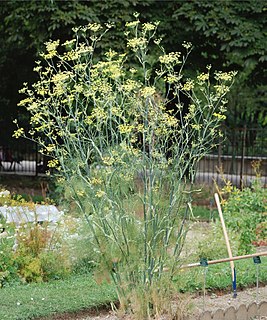
Fennel is a flowering plant species in the carrot family. It is a hardy, perennial herb with yellow flowers and feathery leaves. It is indigenous to the shores of the Mediterranean but has become widely naturalized in many parts of the world, especially on dry soils near the sea-coast and on riverbanks.

Basil, also called great basil, is a culinary herb of the family Lamiaceae (mints).

Chinese herbology is the theory of traditional Chinese herbal therapy, which accounts for the majority of treatments in traditional Chinese medicine (TCM). A Nature editorial described TCM as "fraught with pseudoscience", and said that the most obvious reason why it has not delivered many cures is that the majority of its treatments have no logical mechanism of action.

Herbal medicine is the study of pharmacognosy and the use of medicinal plants. Plants have been the basis for medical treatments through most of human history, and such traditional medicine is still widely practiced today. Modern medicine makes use of many plant-derived compounds as the basis for evidence-based pharmaceutical drugs. Although herbalism may apply modern standards of effectiveness testing to herbs and medicines derived from natural sources, few high-quality clinical trials and standards for purity or dosage exist. The scope of herbal medicine is sometimes extended to include fungal and bee products, as well as minerals, shells and certain animal parts.
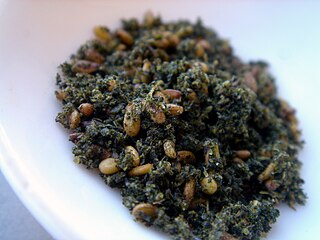
Za'atar is a culinary herb or family of herbs. It is also the name of a spice mixture that includes the herb along with toasted sesame seeds, dried sumac, often salt, as well as other spices. As a family of related Middle Eastern herbs, it contains plants from the genera Origanum (oregano), Calamintha, Thymus, and Satureja (savory) plants. The name za'atar alone most properly applies to Origanum syriacum, considered in biblical scholarship to be the hyssop of the Hebrew Bible. Used in Levantine cuisine, both the herb and spice mixture are popular throughout the Mediterranean region of the Middle East.
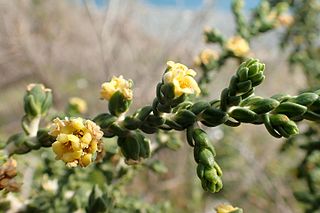
The Thymelaeaceae are a cosmopolitan family of flowering plants composed of 50 genera and 898 species. It was established in 1789 by Antoine Laurent de Jussieu. The Thymelaeaceae are mostly trees and shrubs, with a few vines and herbaceous plants.
Xerosere is a plant succession that is limited by water availability. It includes the different stages in a xerarch succession. Xerarch succession of ecological communities originated in extremely dry situation such as sand deserts, sand dunes, salt deserts, rock deserts etc. A xerosere may include lithoseres and psammoseres.
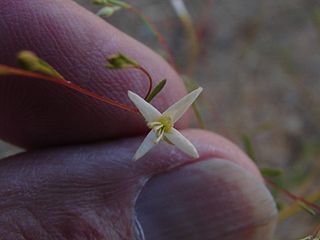
Gayophytum diffusum is a species of flowering plant in the evening primrose family known by the common name spreading groundsmoke. It is native to western North America where it is a common member of many different habitats. This is a spindly, branching annual herb reaching a maximum height of about half a meter. Its thin stems have sparse narrow leaves a few centimeters long. The occasional flowers are petite and usually white in color. The fruit is a cylindrical, knobby capsule up to 1.5 centimeters long.
Gayophytum heterozygum is a species of flowering plant in the evening primrose family known by the common name zigzag groundsmoke. It is native to the western United States where it grows mainly in forested mountain habitat. This is a spindly annual herb with a few forking branches which approaches 80 centimeters in maximum height. It has a sparse foliage of small, narrow leaves, most of which are on the lower half of the plant. It produces tiny white flowers toward the tops of the thin stems. The fruit is a lumpy-looking capsule.
Gayophytum humile is a species of flowering plant in the evening primrose family known by the common name dwarf groundsmoke. It is native to western North America from Alberta to California, and can also be found in parts of South America. It lives in many types of mountain habitats, especially moist areas. It is a small, thin annual herb not exceeding 30 centimeters in height. Its erect stem has few branches and sparse narrow leaves. The stem and leaves are green to bright red, or green with reddish edges and tips. The plant produces tiny white flowers each about half a centimeter across. The fruit is a capsule one to one and a half centimeters long containing up to 50 seeds.
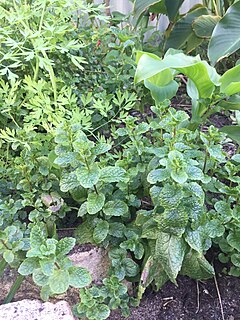
In general use, herbs are plants with savory or aromatic properties that are used for flavoring and garnishing food, for medicinal purposes, or for fragrances; excluding vegetables and other plants consumed for macronutrients. Culinary use typically distinguishes herbs from spices. Herbs generally refers to the leafy green or flowering parts of a plant, while spices are usually dried and produced from other parts of the plant, including seeds, bark, roots and fruits.

Pyrausta unifascialis, the one-banded pyrausta, is a moth in the family Crambidae. It was described by Packard in 1873. It is found in North America, where it has been recorded from Quebec west to British Columbia, south to Arizona and California. The habitat consists of forest openings, clearings and fields.

















